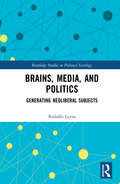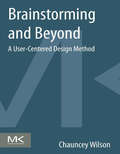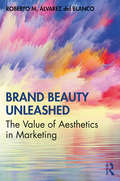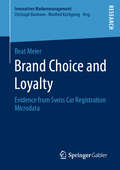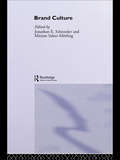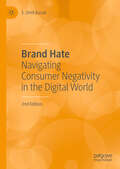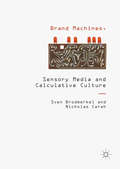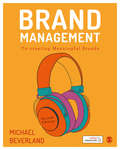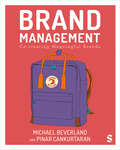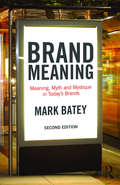- Table View
- List View
Brains, Media and Politics: Generating Neoliberal Subjects (Routledge Studies in Political Sociology)
by Rodolfo LeyvaFollowing the 2007–2008 global financial crisis, a number of prominent academics, journalists, and activists were quick to pronounce the demise of neoliberal capitalism and governance. This rather optimistic prediction, however, underestimated the extent to which neoliberalism has shaped the 21st-century world order and become entrenched in our sociopolitical and cognitive fabric. Indeed, 11 years after the crisis, and in spite of the significant levels of socioeconomic inequality, psychological distress, and environmental destruction generated by neoliberal policies and corresponding business and cultural practices, the ideological hegemony of neoliberalism has not been supplanted, nor has it really faced any serious unsettling. How, then, has neoliberalism inflected and shaped our “common-sense” understandings of what is politically, economically, and culturally viable? To help answer this question, this book combines leading theories from sociology, media-communication research, developmental psychology, and cognitive science, and draws on primary evidence from a unique mix of ethnographic, survey, and experimental studies – of young people’s leisure practices and educational experiences, of young adults’ political socialisation processes in relation to exposure to social networking sites, and of the effects of commercial media viewing on material values and support for social welfare. In doing so, it provides a nuanced and robustly empirically tested account of how the conscious and non-conscious cognitive dimensions of people’s subjectivities and everyday social practices become interpellated through and reproductive of neoliberal ideology. As such, this book will appeal to scholars across the social and behavioural sciences with interests in neoliberalism, political engagement, enculturation, social reproduction, and media effects.
Brains, Media and Politics: Generating Neoliberal Subjects (Routledge Studies in Political Sociology)
by Rodolfo LeyvaFollowing the 2007–2008 global financial crisis, a number of prominent academics, journalists, and activists were quick to pronounce the demise of neoliberal capitalism and governance. This rather optimistic prediction, however, underestimated the extent to which neoliberalism has shaped the 21st-century world order and become entrenched in our sociopolitical and cognitive fabric. Indeed, 11 years after the crisis, and in spite of the significant levels of socioeconomic inequality, psychological distress, and environmental destruction generated by neoliberal policies and corresponding business and cultural practices, the ideological hegemony of neoliberalism has not been supplanted, nor has it really faced any serious unsettling. How, then, has neoliberalism inflected and shaped our “common-sense” understandings of what is politically, economically, and culturally viable? To help answer this question, this book combines leading theories from sociology, media-communication research, developmental psychology, and cognitive science, and draws on primary evidence from a unique mix of ethnographic, survey, and experimental studies – of young people’s leisure practices and educational experiences, of young adults’ political socialisation processes in relation to exposure to social networking sites, and of the effects of commercial media viewing on material values and support for social welfare. In doing so, it provides a nuanced and robustly empirically tested account of how the conscious and non-conscious cognitive dimensions of people’s subjectivities and everyday social practices become interpellated through and reproductive of neoliberal ideology. As such, this book will appeal to scholars across the social and behavioural sciences with interests in neoliberalism, political engagement, enculturation, social reproduction, and media effects.
Brainstorming and Beyond: A User-Centered Design Method
by Chauncey WilsonBrainstorming and Beyond describes the techniques for generating ideas verbally, in writing, or through sketches. The first chapter focuses on brainstorming, the foundation method for ideation, which is a complex social process building off of social psychology principles, motivational constructs, and corporate culture. Brainstorming is commonly portrayed as an easy way to generate ideas, but in reality, it is a complex social process that is often flawed in ways that are not self-evident. Chapter 2 discusses Brainwriting, which is a variation on brainstorming in which each person writes ideas down on paper and then passes the paper to a new person who reads the first set of ideas and adds new ones. Since there is no group shouting out of ideas, strong facilitation skills are not required, and more often than not, Brainwriting results greatly exceed those of group brainstorming in a shorter time because ideas are generated in a parallel, rather than serial, fashion. Brainwriting is useful when time is limited, groups are hostile, or you are dealing with a culture where shouting out wild or divergent ideas might be difficult. Finally, in Chapter 3, readers learn about Braindrawing, a method of visual brainstorming that helps practitioners generate ideas for icons, other graphics, user interface layouts, or Web page designs. Each of these methods provides readers with ways to generate, present, and evaluate ideas so they can begin building a strong foundation for product success. Learn the proper techniques for generating ideas with limited time, hostile audiences, and limited facilitation supportExplores efficient processes for analyzing the value of ideasExamines ways to generate visual as well as textual ideas
Bram Stoker and the Gothic: Formations to Transformations (Palgrave Gothic)
by Catherine Wynne'My revenge is just begun! I spread it over centuries, and time is on my side,' warns Dracula. This statement is descriptive of the Gothic genre. Like the Count, the Gothic encompasses and has manifested itself in many forms. Bram Stoker and the Gothic demonstrates how Dracula marks a key moment in the transformation of the Gothic. Harking back to early Gothic's preoccupation with the supernatural, decayed aristocracy and incarceration in gloomy castles, the novel speaks to its own time, but has also transformed the genre, a revitalization that continues to sustain the Gothic today. This collection explores the formations of the Gothic, the relationship between Stoker's work and some of his Gothic predecessors, such as Poe and Wollstonecraft, presents new readings of Stoker's fiction and probes the influences of his cultural circle, before concluding by examining aspects of Gothic transformation from Daphne du Maurier to Stoker's own 'reincarnation' in fiction and biography. Bram Stoker and the Gothic testifies to Stoker's centrality to the Gothic genre. Like Dracula, Stoker's 'revenge' shows no sign of abating.
Branch-and-Bound Applications in Combinatorial Data Analysis (Statistics and Computing)
by Michael J. Brusco Stephanie StahlThis book provides clear explanatory text, illustrative mathematics and algorithms, demonstrations of the iterative process, pseudocode, and well-developed examples for applications of the branch-and-bound paradigm to important problems in combinatorial data analysis. Supplementary material, such as computer programs, are provided on the world wide web. Dr. Brusco is an editorial board member for the Journal of Classification, and a member of the Board of Directors for the Classification Society of North America.
Brand Beauty Unleashed: The Value of Aesthetics in Marketing
by Roberto M. Álvarez del BlancoThis book presents an in-depth, careful study of our understanding of the concept of beauty in everyday objects and its impact on markets and brands. Moving beyond artistic notions of beauty, it demonstrates how beauty is an asset that can be leveraged in the marketplace. Traditionally, beauty has been examined in relation to its influence on painting, sculpture, literature, music, and architecture. However, its value and power in the marketplace is understudied. Álvarez del Blanco provides a systematic analysis of beauty in commonplace objects and brands, drawing on cutting-edge research at the intersection of marketing and neurosciences. Through examining the neuroscientific evidence for how the brain processes beauty, the author articulates the implications this may have on marketing and brand management. He also offers a glimpse of how beauty may evolve, and its marketing implications for firm strategy in the coming decades. Written by a recognized authority in marketing and brand strategy, Brand Beauty Unleashed gives students with an interest in marketing, consumer behavior, branding, and neuromarketing an exciting new perspective on this intangible asset.
Brand Beauty Unleashed: The Value of Aesthetics in Marketing
by Roberto M. Álvarez del BlancoThis book presents an in-depth, careful study of our understanding of the concept of beauty in everyday objects and its impact on markets and brands. Moving beyond artistic notions of beauty, it demonstrates how beauty is an asset that can be leveraged in the marketplace. Traditionally, beauty has been examined in relation to its influence on painting, sculpture, literature, music, and architecture. However, its value and power in the marketplace is understudied. Álvarez del Blanco provides a systematic analysis of beauty in commonplace objects and brands, drawing on cutting-edge research at the intersection of marketing and neurosciences. Through examining the neuroscientific evidence for how the brain processes beauty, the author articulates the implications this may have on marketing and brand management. He also offers a glimpse of how beauty may evolve, and its marketing implications for firm strategy in the coming decades. Written by a recognized authority in marketing and brand strategy, Brand Beauty Unleashed gives students with an interest in marketing, consumer behavior, branding, and neuromarketing an exciting new perspective on this intangible asset.
Brand Choice and Loyalty: Evidence from Swiss Car Registration Microdata (Innovatives Markenmanagement)
by Beat MeierBy analyzing a large car registration dataset, Beat Meier shows various aspects of consumer behavior in the context of durable goods. He thereby isolates various influences on purchase decisions, e.g. the brand owned before, the price, and demographic variables. Furthermore, he investigates the short-term effects of tax incentives and reputation shocks on brand choice and brand loyalty. The dataset used is very unique and allows a longitudinal examination of the cars owned by a person. This permits to gain insights on consumer behavior of durable goods that are relatively expensive and bought infrequently.
Brand Culture
by Jonathan E. Schroeder Miriam Salzer-MörlingThis fascinating book shows that neither managers nor consumers completely control branding processes – cultural codes constrain how brands work to produce meaning. Placing brands firmly within the context of culture, it investigates these complex foundations. Topics covered include: the role of consumption brand management corporate branding branding ethics the role of advertising. This excellent text includes case studies of iconic international brands such as LEGO, Nokia and Ryanair, and analysis by leading researchers including John M.T. Balmer, Stephen Brown, Mary Jo Hatch, Jean-Noël Kapferer, Majken Schultz, and Richard Elliott. An outstanding collection, it will be a useful resource for all students and scholars interested in brands, consumers and the broader cultural landscape that surrounds them.
Brand Culture
by Jonathan Schroeder Miriam Salzer MorlingThis fascinating book shows that neither managers nor consumers completely control branding processes – cultural codes constrain how brands work to produce meaning. Placing brands firmly within the context of culture, it investigates these complex foundations. Topics covered include: the role of consumption brand management corporate branding branding ethics the role of advertising. This excellent text includes case studies of iconic international brands such as LEGO, Nokia and Ryanair, and analysis by leading researchers including John M.T. Balmer, Stephen Brown, Mary Jo Hatch, Jean-Noël Kapferer, Majken Schultz, and Richard Elliott. An outstanding collection, it will be a useful resource for all students and scholars interested in brands, consumers and the broader cultural landscape that surrounds them.
Brand Equity & Advertising: Advertising's Role in Building Strong Brands
by David A. Aaker Alexander L. BielThe tenth annual Advertising and Consumer Psychology Conference held in San Francisco focused on branding -- a subject generating intense interest both in academia and in the "real world." The principle theory behind these conferences is that much can be gained by joining advertising and marketing professionals with academic researchers in advertising. Professionals can gain insight into the new theories, measurement tools and empirical findings that are emerging, while academics are stimulated by the insights and experience that professionals describe and the research questions that they pose. This book consists of papers delivered by experts from academia and industry discussing issues regarding the role of advertising in the establishment and maintenance of brand equity -- making this volume of interest to advertising and marketing specialists, as well as consumer and social psychologists.
Brand Equity & Advertising: Advertising's Role in Building Strong Brands (Advertising And Consumer Psychology Ser.)
by David A. Aaker Alexander L. BielThe tenth annual Advertising and Consumer Psychology Conference held in San Francisco focused on branding -- a subject generating intense interest both in academia and in the "real world." The principle theory behind these conferences is that much can be gained by joining advertising and marketing professionals with academic researchers in advertising. Professionals can gain insight into the new theories, measurement tools and empirical findings that are emerging, while academics are stimulated by the insights and experience that professionals describe and the research questions that they pose. This book consists of papers delivered by experts from academia and industry discussing issues regarding the role of advertising in the establishment and maintenance of brand equity -- making this volume of interest to advertising and marketing specialists, as well as consumer and social psychologists.
Brand Gender als Markenpersönlichkeit: Wie starke Charaktere große Marken schaffen
by Theo LievenDieses Buch untersucht Möglichkeiten, die wichtigste Eigenschaft einer Marke, nämlich ihren Wert, zu steigern. Mit dem Fokus auf das Brand Gender analysiert Theo Lieven, wie sich die Projektion von Persönlichkeitsmerkmalen auf Marken auswirkt und wie Marken sich damit effektiv und effizient führen lassen. Anhand detaillierter Beispiele argumentiert er, dass indifferente Marken mit schwachen männlichen und weiblichen Merkmalen den geringsten Wert haben, während androgyne Marken mit sowohl starken weiblichen als auch starken männlichen Merkmalen den höchsten Wert aufweisen. Es wird aufgezeigt, welche Faktoren dazu führen, dass eine Marke als männlich und/oder als weiblich wahrgenommen wird. Mit dem Ziel, eine umfassende Theorie zu entwickeln und Praktikern einen Leitfaden zur Steigerung des Werts ihrer Marken zu geben, legt dieses Buch die Grundlage für ein globales Markenpersönlichkeitsmodell.
Brand Hate: Navigating Consumer Negativity in the Digital World
by S. Umit KucukThis book focuses on the concept of “brand hate” and consumer negativity in today’s digital markets. It explores the emotional detachment consumers generate against valued brands and how negative experiences affect their and other consumers' loyalty. It is almost impossible not to run into hateful language about companies and their brands in today’s digital consumption spaces. Consumer hostility and hate is not hidden and silent anymore but is now openly shared on many online anti-brand websites, consumer social networking sites, and complaint and review boards. The book defines consumer brand hate and discusses its dimensions, antecedents, and consequences as well as the semiotics and legality of such brand hate activities based on current brand dilution arguments. It describes the situations which lead to anti-branding and how consumers choose to express their dissatisfaction with a company on individual and social levels. This newly updated edition discusses recent research findings from brand hate literature with new cases and extended managerial analysis. Thus, the book provides strategic perspectives on how to handle such situations to achieve better functioning markets for scholars and practitioners in marketing, psychology, and consumer behavior.
Brand, Label, and Product Intelligence: Second International Conference, COBLI 2021 (Springer Proceedings in Business and Economics)
by Joseph Kaswengi Aurore IngaraoThis book contains the latest and most up-to-date research results from the fields of brands, labels and product, presented at the international colloquium COBLI 2021, held in Orleans, France. It covers a wide range of topics from the fields of economics, psychology, information technology and social sciences. In particular, the book deals with various areas of application such as consumer behavior in the omnichannel, the influence of the coronavirus pandemic on attitudes and customer behavior, franchising, origin labelling, transparency in the agri-food industry, tourism and the triptych of brand/label/product. The contributions are gathered under the following main topics: Consumer behavior and decisions, labeling strategy, brand market trends, branding of local brands, territorial impact on brand/label/product, theoretical and managerial research methods.
Brand Love is not Enough: A Theory of Consumer Brand Relationships in Practice
by Max BlackstonHow would you feel about a bank that handled all of your financial needs efficiently, but made you feel like a dummy? In a relationship between two people, what the other person thinks of you (or what you believe they think of you) exerts great influence on the quality of your relationship. The same is true for your relationship with brands. In this trailblazing book, Blackston extends his theory on consumer brand relationships introduced in the 1990s. He introduces a new construct called "brand's attitude," which complements the idea of brand image and introduces a typology of consumer relationships that is richer and more varied than the familiar concept of brand love. This construct describes more fully the two-way street that exists between consumers and brands, and fills a crucial gap in traditional branding literature in explaining consumers’ brand purchasing and usage behavior. Drawing on numerous actual examples and cases from a variety of different industries, and supported by 30 years of consumer data, Brand Love is not Enough should be on the shelf of any serious marketer or student of branding.
Brand Love is not Enough: A Theory of Consumer Brand Relationships in Practice
by Max BlackstonHow would you feel about a bank that handled all of your financial needs efficiently, but made you feel like a dummy? In a relationship between two people, what the other person thinks of you (or what you believe they think of you) exerts great influence on the quality of your relationship. The same is true for your relationship with brands. In this trailblazing book, Blackston extends his theory on consumer brand relationships introduced in the 1990s. He introduces a new construct called "brand's attitude," which complements the idea of brand image and introduces a typology of consumer relationships that is richer and more varied than the familiar concept of brand love. This construct describes more fully the two-way street that exists between consumers and brands, and fills a crucial gap in traditional branding literature in explaining consumers’ brand purchasing and usage behavior. Drawing on numerous actual examples and cases from a variety of different industries, and supported by 30 years of consumer data, Brand Love is not Enough should be on the shelf of any serious marketer or student of branding.
Brand Machines, Sensory Media and Calculative Culture
by Nicholas Carah Sven BrodmerkelThis study argues that the defining feature of contemporary advertising is the interconnectedness between consumer participation and calculative media platforms. It critically investigates how audience participation unfolds in an algorithmic media infrastructure in which brands develop media devices to codify, process and modulate human capacities and actions.With the shift from a broadcast to an interactive media system, advertisers have reinvented themselves as the strategic interface between computational media systems and the lived experience and living bodies of consumers. Where once advertising relied predominantly on symbolic appeals to affect consumers, it now centres on the use of computational devices that codify, monitor, analyse and control their behaviours. Advertisers have worked to stimulate and harness consumer participation for several generations. Consumers undertook the productive work of making brands a part of their cultural identities and practices. With the emergence of a computational mode of advertising consumer participation extends beyond the expressive activity of creating and circulating meaning. It now involves making the lived experience and the living body available to the experimental capacities of media platforms and devices. In this mode of advertising brands become techno-cultural processes that integrate calculative and cultural functions. Brand Machines, Sensory Media and Calculative Culture conceptualises and theorises these significant changes in advertising. It takes consumer participation and its interconnectedness with calculative media platforms as the fundamental aspect of contemporary advertising and critically investigates how advertising, consumer participation and technology are interrelated in creating and facilitating lived experiences that create value for brands.
Brand Management: Co-creating Meaningful Brands
by Michael BeverlandPresenting the basics of brand management, the book provides both a theoretical and practical guide to brands, placing emphasis on the theory that the consumer is a co-creator in a brand′s identity. In a world in which social media and inclusive digital platforms have increased customer engagement, the role of brands and branding has changed. The line between the producer and the consumer has become blurred; consumers are no longer the recipients of brand identity, but the co-creators, playing a significant role in shaping new products and systems. Case studies include the Canterbury Crusaders, KVD Beauty, Kodak, Yamaha, Ottobock and Holland′s rebrand as The Netherlands.
Brand Management: Co-creating Meaningful Brands
by Michael BeverlandPresenting the basics of brand management, the book provides both a theoretical and practical guide to brands, placing emphasis on the theory that the consumer is a co-creator in a brand′s identity. In a world in which social media and inclusive digital platforms have increased customer engagement, the role of brands and branding has changed. The line between the producer and the consumer has become blurred; consumers are no longer the recipients of brand identity, but the co-creators, playing a significant role in shaping new products and systems. Case studies include the Canterbury Crusaders, KVD Beauty, Kodak, Yamaha, Ottobock and Holland′s rebrand as The Netherlands.
Brand Management: Co-creating Meaningful Brands
by Michael BeverlandPresenting the basics of brand management, the book provides both a theoretical and practical guide to brands, placing emphasis on the theory that the consumer is a co-creator in a brand′s identity. In a world in which social media and inclusive digital platforms have increased customer engagement, the role of brands and branding has changed. The line between the producer and the consumer has become blurred; consumers are no longer the recipients of brand identity, but the co-creators, playing a significant role in shaping new products and systems. Case studies include the Canterbury Crusaders, KVD Beauty, Kodak, Yamaha, Ottobock and Holland′s rebrand as The Netherlands.
Brand Management: Co-creating Meaningful Brands
by Michael Beverland Pinar CankurtaranThis popular textbook introduces students to contemporary brand management and innovation with a focus on how companies and consumers are interacting and co-creating brands today. The latest edition continues to provide equal focus on theory and practice with all new case studies and examples from brands around the globe to help show the wide range and diversity of brands and consumers today. These include Glossier, Lovehoney, Whisper, Shinola Detroit, Trung Nguyen, Shatta Wale, Tony’s Chocolonely. Also included are updated research references and online resources, as well as a brand-new chapter on the creative aspects of branding from naming to logos and experiences. This textbook is essential reading for all students studying branding and brand management at university level. Michael Beverland is Professor of Brand Marketing at University of Sussex Business School. Pinar Cankurtaran is Assistant Professor of Brand Strategy at the Faculty of Industrial Design Engineering, Delft University of Technology.
Brand Management: Co-creating Meaningful Brands
by Michael Beverland Pinar CankurtaranThis popular textbook introduces students to contemporary brand management and innovation with a focus on how companies and consumers are interacting and co-creating brands today. The latest edition continues to provide equal focus on theory and practice with all new case studies and examples from brands around the globe to help show the wide range and diversity of brands and consumers today. These include Glossier, Lovehoney, Whisper, Shinola Detroit, Trung Nguyen, Shatta Wale, Tony’s Chocolonely. Also included are updated research references and online resources, as well as a brand-new chapter on the creative aspects of branding from naming to logos and experiences. This textbook is essential reading for all students studying branding and brand management at university level. Michael Beverland is Professor of Brand Marketing at University of Sussex Business School. Pinar Cankurtaran is Assistant Professor of Brand Strategy at the Faculty of Industrial Design Engineering, Delft University of Technology.
Brand Management: Co-creating Meaningful Brands
by Michael Beverland Pinar CankurtaranThis popular textbook introduces students to contemporary brand management and innovation with a focus on how companies and consumers are interacting and co-creating brands today. The latest edition continues to provide equal focus on theory and practice with all new case studies and examples from brands around the globe to help show the wide range and diversity of brands and consumers today. These include Glossier, Lovehoney, Whisper, Shinola Detroit, Trung Nguyen, Shatta Wale, Tony’s Chocolonely. Also included are updated research references and online resources, as well as a brand-new chapter on the creative aspects of branding from naming to logos and experiences. This textbook is essential reading for all students studying branding and brand management at university level. Michael Beverland is Professor of Brand Marketing at University of Sussex Business School. Pinar Cankurtaran is Assistant Professor of Brand Strategy at the Faculty of Industrial Design Engineering, Delft University of Technology.
Brand Meaning: Meaning, Myth and Mystique in Today’s Brands
by Mark BateyThis second edition of Brand Meaning lays out new territory for the understanding of how brands both acquire and provide meaning. The author draws on his experience with leading international companies to propose a compelling framework for the conscious and unconscious ways in which people connect with products and brands. Revised and updated, it contains contemporary as well as classic examples of brand meaning in practice from various countries, and expands on the theory, methods and applications of brand meaning. The book’s multidisciplinary approach and concise yet comprehensive content makes it an ideal supplemental reader for undergraduate, graduate, and MBA courses, as well as valuable reading for practitioners in the fields of marketing, advertising and consumer research. For more information, visit www.brandmeaning.com.
